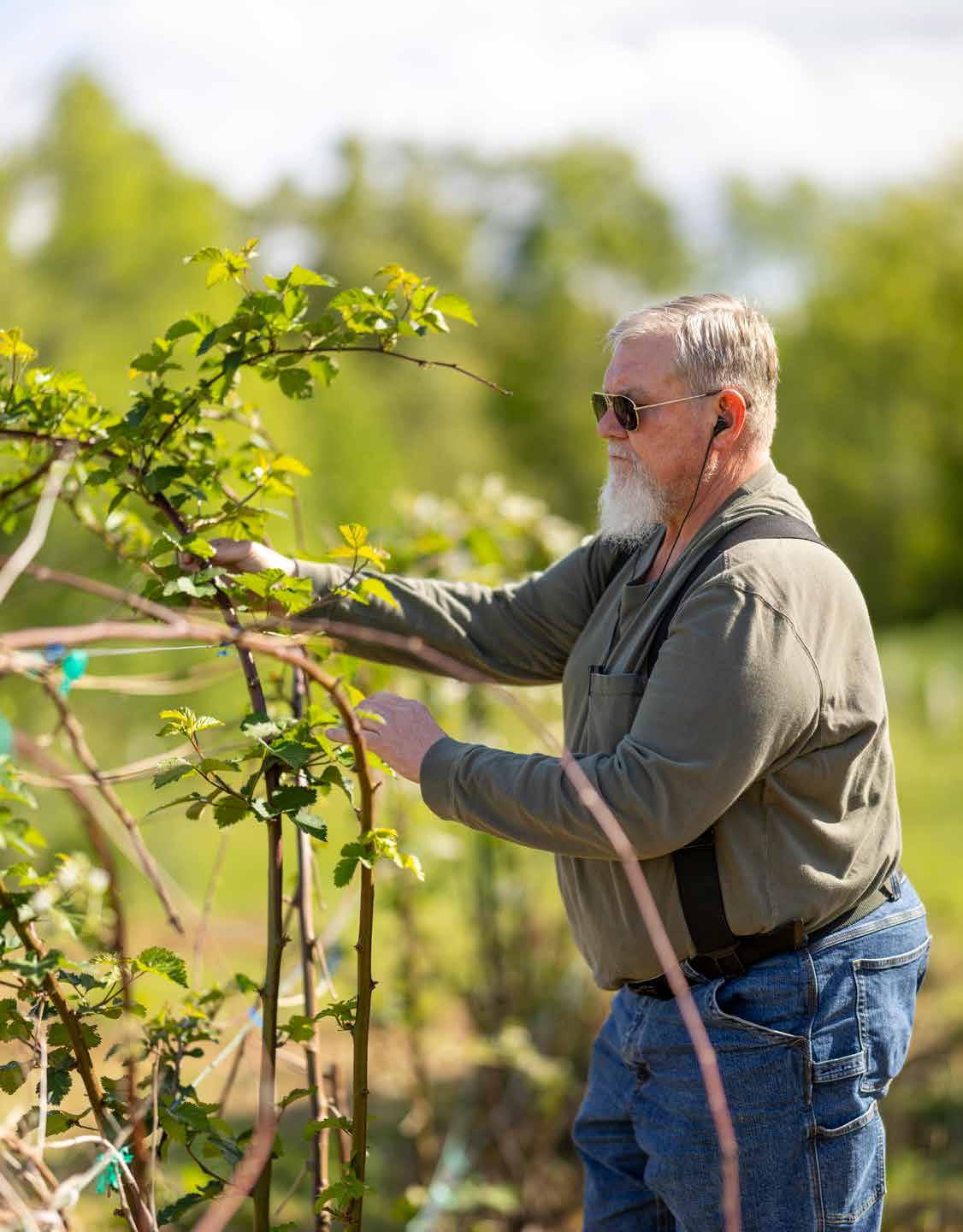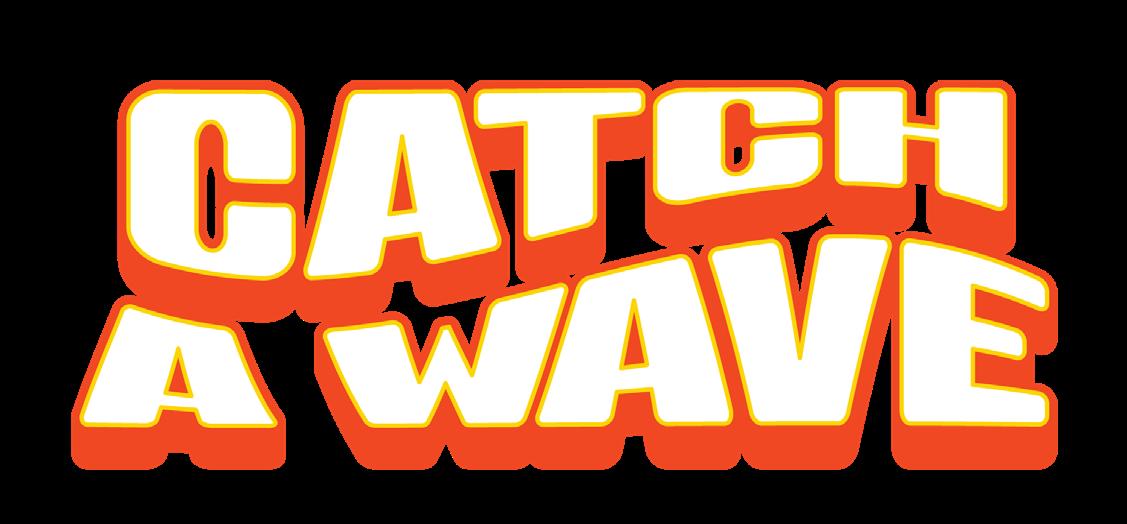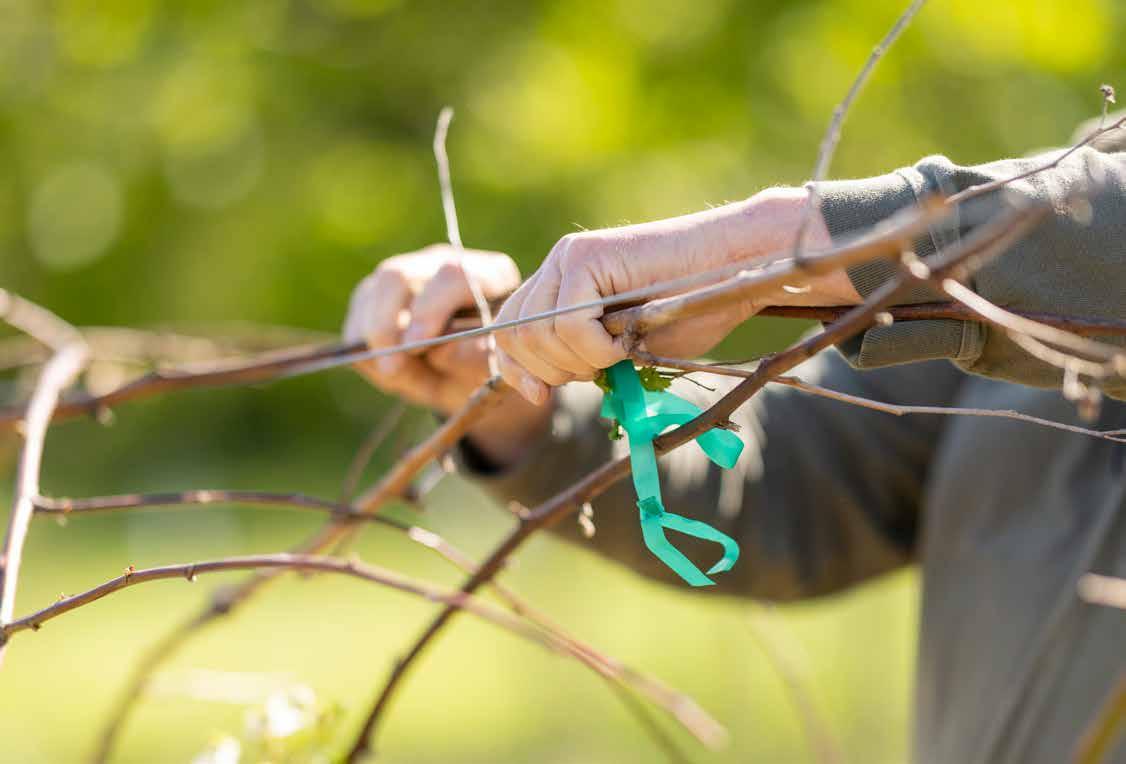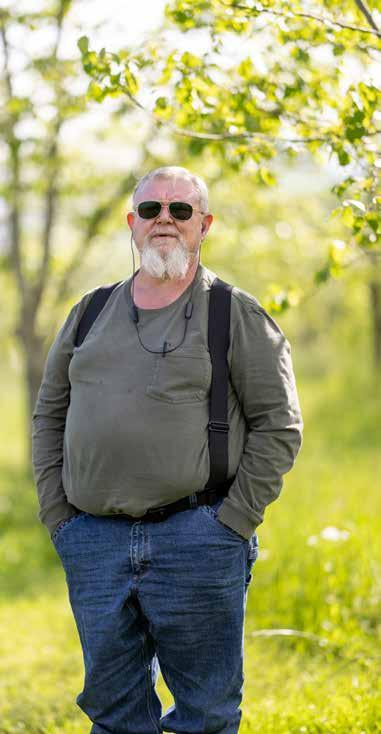


Top Trees
England’s Orchard






By Shirley Bloomfield, CEO NTCA–The Rural Broadband Association
Celebrate decades of digital innovation
World Wide Web Day is Aug. 1. It’s a celebration of a 1993 internet milestone that transformed our society, changing everything from work and health care to communications and entertainment.
Before the web, accessing information and resources on the interconnected computers spanning the globe required specific software and skills. Email use was even limited—in business, fax machines still ruled. Then, researchers in Switzerland, including Tim Berners-Lee, developed the World Wide Web. Not only was information easier to share, but the freely distributed tools that made it possible fueled decades of innovation.
Now, rural internet service providers like yours manage the high-speed networks unlocking the modern web. NTCA’s 2024 Broadband/Internet Availability Survey Report showed that 89% of rural customers served by providers responding to the survey have access to speeds of at least 100 Mbps.
That’s a dramatic change compared to 1993, when connecting was slow and noisy, reliant on dial-up modems and copper lines. Back then, a speed of 14.4 Kbps was great—nearly 7,000 times slower than a 100 Mbps connection today.
Students can now access endless resources online and attend virtual classes. Telemedicine brings services and specialists otherwise unavailable in rural communities. Farmers monitor crops, manage resources and keep livestock healthy with internet-connected tools. And that’s only the beginning.
NTCA members across rural America make it all possible. So, let’s take a moment to celebrate not only World Wide Web Day, but also the communications professionals in your community.
Thank you for all you do.
Local businesses are a cornerstone of the United States’ economy, particularly in rural communities. You need to look no further than your local utility providing a fast, reliable internet network. Companies like these are not only committed to providing excellent service but also uplifting their communities.
A report last year by Capital One Shopping, a site operated by the banking and credit card company, highlighted the importance of local retailers.
• In one week, 91% of American consumers shop at small and local stores.
• 68%, or $68 out of every $100, spent at local stores remains in the local economy.
• American shoppers spent an estimated $4.51 trillion at local stores in 2023, equivalent to 54.3% of all retail sales
• The average person shops locally 213 times per year or once every 1.7 days
• Shopping small keeps dollars local.
• Dollars spent at an independent business may recirculate in the local economy an average of six to 15 times
• Small businesses make up to 136% more charitable donations per employee than businesses with 500 or more employees.
• Residents of communities with more independent businesses drive three-quarters fewer miles than their neighbors who have less access to small local shops.

Long days outdoors are a joy of summer. A little sun can even increase your vitamin D levels, which has a range of health benefits. On the other hand, bathing in too much sunlight is not good for the skin, raising the potential for skin cancer. And some people are more susceptible than others.
So, it just makes sense to track and manage sun exposure. Think about all the things we already monitor—steps, sleep and even what we eat. Why not also track exposure to ultraviolet light, the rays produced by the sun?
In fact, your phone’s weather app may already offer a forecast for expected sun exposure at your location. Other apps though can ramp up the details. Early UV apps were basically glorified timers with general advice tacked on. Today’s versions
are more sophisticated, providing information on everything from cloud cover to how much sun is reflecting off surfaces around you.
These apps often have easy-to-understand color-coded displays that show your risk level. Most will customize their recommendations based on your skin type, which means you’re getting advice that’s relevant to you specifically.
Some of the more advanced options do more than track UV exposure. They can use your smartphone’s camera to analyze your features and suggest proper levels of sun protection. Many will even send timely reminders when it’s time to reapply sunscreen based on your activity level and which products you’re using.
The more comprehensive sun safety apps don’t only monitor UV rays. They
include educational content about sun damage and skin cancer prevention. Some even track vitamin D production, helping you balance protection with healthy sun exposure.
Family-friendly versions allow users to set up profiles for multiple family members with different skin types, making it much easier to manage sun protection during group outings like beach days or picnics. Of course, no apps replace a proper checkup with your dermatologist, but they do offer daily reminders about a danger we can’t always see. So, next time you’re heading outdoors for a day in the sun, check the app store for your favorite device and see if there’s an app that provides the details you need to stay safe. At minimum, the apps can keep the importance of skin protection top of mind.
Ialways enjoy these long, sunny days, which are perfect for slowing down and spending time with the people who matter most. It’s an opportunity to unplug and enjoy the outdoors, and at PRTC we believe the communications services we provide can help connect us in person and online.

KEITH GABBARD Chief Executive Officer
Have you ever noticed how we can all get stuck looking at our phones? Even though our internet connects thousands of homes and businesses, the best connections often happen when we look up and see each other face to face. This summer, I invite everyone to find that sweet spot, using our internet to make your real-life get-togethers even better.
Think about that family reunion you’re planning. Group texts make organizing easy. Video calls let you chat with relatives who moved away. When everyone finally gets together, your phone can capture precious moments and then store, edit and share those images online. Fast reliable internet makes it all possible.
Similarly, our local markets and festivals thrive because vendors can easily process card payments without the need for expensive and complex systems. And they can keep potential customers updated by posting online about sales and new products. But being out and about shopping is still an opportunity for connections where neighbors meet in person, shake hands and catch up.
Also, thanks to rich and affordable streaming services for music and video, families can gather indoors or outside for movie nights. Perhaps some things that start small can grow into monthly traditions where neighbors become friends.
At PRTC, we don’t just support a fast, industry-leading internet service. We believe these resources can create paths to new possibilities. Your stories of connection and success fuel our passion—grandparents who video chat with grandkids, local businesses that ship to customers around the nation or young artists sharing digital creations with the world.
This summer, try using technology with purpose. Create a shared family photo album that relatives can add to from anywhere. Use social media to organize a park cleanup day. Stream music for an impromptu block party. Record video interviews with town leaders to save and share their stories.
The best communities blend new technology with cherished traditions. At PRTC, our investment in this community allows us to use technology to make our ties to one another stronger. As we enjoy summer, remember that our most important connections will always be with each other. We are proud to provide the technology that helps those connections grow. Let’s make this a summer of real connection, both online and in person.


The PRTC Connection is published by Peoples Rural Telephone Cooperative, ©2025. It is distributed without charge to all members of the cooperative.


is your member-owned cooperative serving Jackson and Owsley counties in East Kentucky. The cooperative is dedicated to using technology to keep its members connected through high-speed broadband internet, digital and HD television, wireless 4G phone service, local and long-distance calling and beyond.
Send address corrections to:
Peoples Rural Telephone Cooperative P.O. Box 159 McKee, KY 40447
606-287-7101 • 606-593-5000 prtcnet.org
BOARD OF DIRECTORS
BOARD
Kendall Norris
President
Wendell Gabbard
Kendall Gabbard
Vice President
James Gary Cornett
James Cornett
Secretary
Nelson Bobrowski
Treasurer
Donald Barrett
Armel Davidson
Pat Henderson
Henderson your member-owned cooperative serving Jackson and Owsley counties in East Kentucky. The cooperative is dedicated to using technology to keep its members connected through highbroadband internet, digital and HD television, wireless 4G phone service, local and long-distance calling and beyond.
On the Cover:

Clifford England founded England's Orchard in McKee. The orchard is known across the world for its fruit and nut trees, as well at its berry bushes.
See story Page 12.














Story by KATHY DENES
If summer has a signature scent aside from freshly mowed grass, it’s the chlorine of swimming pools and water slides. Water parks are the ultimate hot-weather attractions, and some have been popping up lately that go far beyond splash pads and lazy rivers. These parks lure the adventurous with endless waves and whitewater for rafting, kayaking, canoeing and even surfing—no wild oceans or rivers required.
The first of these parks in the country, the U.S. National Whitewater Center in Charlotte, North Carolina, is home to a whitewater river that challenges even the most experienced wave riders. Touted as the world’s largest artificial river, its recirculating treated water flows along dual concrete channels offering rapids
varying in intensity from Class II to Class IV.
The sprawling facility is geared to all sorts of outdoor recreation and is still evolving nearly 20 years after opening. Guided rafts and kayakers with whitewater experience ride the same rapids U.S. Olympic athletes use for training and team trials. The Wilderness and Competition channels provide varying intensity and length before ending in the tranquil pool where riders steer their boats onto a conveyor belt and ride back to the start for another go.
“The USNWC was the first whitewater channel specifically designed for family-level fun at an Olympic-standard facility,” says course lead designer Scott Shipley, an engineer, kayak champion
and three-time Olympian who holds four world titles. “Until Charlotte, every whitewater channel in the world was an Olympic channel first that was later adapted for commercial rafting. We created a channel for family recreational rafting first and then added a competition channel. We focused on the church and school groups that will be using it as a way to help get them active.”
At Riversport OKC in Oklahoma City, Olympic and Paralympic athletes train in rowing as well as canoe and kayak. In fact, it is slated to be the canoe slalom venue for the 2028 Los Angeles Olympics. Its whitewater center offers rowing, kayaking and surfing lessons,


ABOVE: Progressing from bodyboarding to kneeboarding takes very little time with FlowRider’s perpetual waves.
OPPOSITE PAGE: Rafting can get pretty wild on Riverpark Rapids in downtown Oklahoma City.
along with tubing, paddleboarding, highspeed slides and even fun on dry land.
Riverpark Rapids whitewater rafting and kayaking center is in Riversport Adventure Park, in the Boathouse District along the Oklahoma River. Whitewater kayaking and guided rafting start at the top of the artificial river, reached via a conveyor belt. From there, it’s an easy slide into the river to start a memorable ride.
Those ready to Surf OKC can catch a wave, no previous skill needed. Starting with bodyboarding, the staff teaches all the basics to help visitors hang 10. Wipeouts are inevitable, but there are no sharks in the nonstop waters of the FlowRider surf machine. Found all over the world, these compact wavemakers keep endless, shallow water flowing atop a trampolinelike surface.
TEST THE WATERS
Riverpark OKC is open daily 10 a.m. to 5 p.m. in the summer and on weekends in the late spring and early fall. Day passes and memberships are available. Each Thursday through Aug. 7, Riverpark offers NightWater Evening Rafting from 6-8 p.m. riversportokc.org
The Charlotte Whitewater Center will celebrate Independence Day by hosting a free two-day festival, July 3 and 4, with live music and more. Evening events those days include illuminated rafting

one of the six levels of SandRidge Sky Trail.

In the hills above Charlotte, North Carolina, the U.S. National Whitewater Center caters to whitewater enthusiasts ranging from novice paddlers to Olympic athletes.
and kayaking on the river’s Competition Channel, but this requires purchase of an activity pass. See the center’s website for schedules, pass information and events, plus details about any required gear and skill prerequisites. whitewater.org.
Montgomery, Alabama—Whitewater paddlers of all skill levels can enjoy the thrills of rafting or kayaking at Montgomery Whitewater, complete with a 1,600-foot Competition Channel and 2,200-foot Creek Channel. To open its season, Montgomery Whitewater hosted the 2025 Pan American Canoe Slalom and Kayak Cross Championships. It was the site of the U.S. Canoe/Kayak Slalom Olympic team trials for the 2024 Paris games. For more, go to montgomerywhitewater.com.
Sevierville, Tennessee—Before the 2020 opening of Soaky Mountain, surfer Ben Gravy tested its waters, posted his rides on YouTube and declared the park has the “best manmade novelty wave in America—one of the best on the planet.” Soaky Mountain is open daily in July and August and on weekends in September.
Check out soakymountainwaterpark.com.
Rock Hill, South Carolina—Two custom lakes at SouthTown Wake Park await wakeboard riders 7 and older, and there isn’t a boat in sight. Boarders hold ski ropes pulled by overhead cables. Beginners can sign up for lessons on the smaller lake, while the larger lake is equipped with jump ramps and other features that let advanced wakeboarders work on extreme moves. There’s also Aqua Park for paddleboards, as well as an obstacle course on floating inflatables and onshore games.
Get all the details at southtownwakepark.com.



PRTC looks for ways to offset rodents’ expensive tastes

Greg Rose likes to joke he’s made a pretty good living from squirrels. “I told our CEO that I can’t really hate them too much,” says the PRTC cable splicer. “I’ve sent my boy to college on them.”
But when he’s not joking about them, Greg is cursing the furry pests that interrupt internet service and cost companies like PRTC hundreds of thousands of dollars in damage.
“Squirrels go out on the line, and they chew up the fiber,” he says. “They chew all the way through the black plastic jacket on the outside of the line and get right into the actual fibers that are inside the cable. It’s a very, very serious problem.”
Not only does a chewed fiber line halt internet service in an affected area, it can also put a stop to cellphone service in some situations.
Whether it’s the taste of the strands that squirrels love or if it’s their favorite chew toy, Greg’s not sure. He only knows squirrel damage is an increasingly frustrating and costly problem facing PRTC and other rural broadband providers across the state.
The frequency of the damage can range from one repair a week to one per day, depending on the time of year. In general, it’s worse from early spring into early fall when squirrels are foraging to feed their young before tree mast ripens, Greg says. Tree fruits and nuts are collectively called mast, and it’s a critical food supply for many forms of wildlife.
The geography of Eastern Kentucky doesn’t help, either. “We’re in the mountains, so it’s heavily forested,” he says. “We’ve got a lot of squirrels.”
The repairs aren’t always simple, either. When a squirrel damages one of PRTC’s aerial cables, crews first have to find the damage. Then they have to find a way to get to it, which isn’t always easy in the woods. After that, they’ve got to replace the entire section of the line, not just the damaged part. The process usually involves a multiperson crew to remove the old cable and install the new one.
“We’re serving a good-sized area, too,” Greg says. “It includes Jackson and Owsley counties and parts of Lee, Laurel, Rockcastle and Clay. I’m going to estimate squirrel damage has cost our company at least $750,000 a year, maybe more.”
To better understand the problem, it’s important to understand the cable. Fiber optic cable transmits data using light signals through thin strands of glass or plastic. Unlike the older copper cables that used electrical signals to transmit data, fiber is much faster, less prone to interference and far less likely to degrade a signal over long distances.
PRTC completed its fiber optic network in Jackson and Owsley counties over 11 years ago, long before many large metropolitan areas started fiber builds. In the beginning, PRTC used a type of loose tube cable that was industry standard when the infrastructure was first installed. That, says Greg, is the type of cable the squirrels like best.
The loose tube cable contains colored tubes with individual fibers inside. In Owsley County, PRTC was forced to replace almost an entire route—at a cost of about $200,000—after squirrels repeatedly damaged the same section of cable.
“I don’t know what it is they like about that jacket of that cable,” Greg says. “I don’t know if it’s a teething problem or something that they’re lacking in their diet or some kind of mineral they get out of it.”
Because of this, PRTC no longer buys the loose tube cable, preferring instead to buy ribbon cable––where fibers are glued together in a ribbon-like formation––and sometimes an armored cable that includes a metal shield as an added deterrent. Ribbon cable is less susceptible to squirrel damage, but it’s not entirely squirrel-proof.
Despite the constant squirrel wars, PRTC still tries to get any outages back up as soon as possible. “That’s what our CEO, Keith Gabbard, has said ever since we were a copper plant,” Greg says. “If you had a subscriber call in at 3 p.m., whether it was phone or internet, we tried to get it done by dark.”
It’s not always easy or doable, however, especially during the squirrelly season. Greg knows the signs, though. “When you get subscribers calling in––four or five on the same route, the same little road––you know something’s happened. And sometimes, a lot of times, it’s going to be squirrels.”
Story by DREW WOOLEY
Born into the world of smartphones and social media, today’s teenagers spend more time communicating online than any of their predecessors. While that familiarity with the online world builds skills with digital platforms, it also affects how they experience adolescence.
“We see that a lot of their development is shaped through their interactions with technology,” says Kaitlyn Burnell, director of research for the University of North Carolina at Chapel Hill’s Winston Center for Technology and the Developing Mind. “It’s not just reflecting those aspects of development but also fundamentally changing how they’re going through those experiences.”

Experts say the key to making sure those changes are positive is understanding how teens are communicating online and giving them the knowledge to shape their own experiences.
Social media is often the most public form of online communication for young people and an easy way to communicate on a large scale. While social status and approval from peers has always been important for adolescents, Burnell says that influence is amplified by social media’s ability to track those reactions in real time.
“Adolescents place a lot of importance on the number of likes and the quality of the comments they’re getting,” she says. “There’s no real counterpart of that in the past. The best thing I can come up with is maybe the number of yearbook signatures or something old school like that. But it’s very, very different.”
That isn’t always a bad thing. While image-heavy platforms like Instagram can lead some to struggle with body image, recent studies show a well-curated social media feed can inspire young people more than discourage them. Many teens understand how their feeds work.
“To adolescents’ credit, they’re pretty sophisticated in tailoring their algorithms,” says Michaeline Jensen, University of North Carolina at Greensboro associate professor. “If they’re not liking what they’re getting, they game it—unfollow some stuff or press the thumbs down to try and steer toward different content. They’re pretty sophisticated with trying to make their online spaces a place that’s affirming and positive for them.”
Direct messaging is reserved for more personal interactions. Private messages are the go-to way to express love, get emotional support or just check in with a parent.
“It’s how they talk to people who really matter to them,” Jensen says. “Things like day-to-day logistical stuff can make parenting easier, so you can check in and get work done. But it does seem like when teens have those more emotionally supportive conversations over text, those seem to be perceived positively by the kids.”
Written chats proved to be more popular than video chats even during periods of separation like the coronavirus pandemic. While video calls can be an authentic way to communicate with faraway family, the interface can prove distracting when talking to other teens.
“Hypothetically, video communication should be more enriching because it’s as close to a face-to-face conversation as you can get,” Burnell says. “However, the problem that we’ve identified is that
the default for most software is that you see yourself and that isn’t always great. If you’re occupied with how you look, then that’s going to impede those social benefits.”
Teens often spend social time gaming online, whether with local friends or players across the world. While there are concerns about this hurting offline relationships, Sophie Janicke-Bowles, an associate professor at California’s Chapman University, found the opposite can be true.
“When it comes to kids hanging out with friends, social gaming is taking that over,” she says. “And it can actually increase both the online and offline connection when hanging out with friends. So, it can be a contributor to more social interaction rather than less.”
Gaming spaces can still expose players to coarse language or bullying. An awareness of how those platforms are used and who they are exposing adolescents to is crucial for creating a positive experience.
Building digital literacy can be challenging in rural areas, where the digital divide is closing but schools may not have resources to teach how to make the most of digi tal communication.
“It makes sense that if families are more spread out from each other you can’t just go next door and hang out with your friend,” Jensen says. “There might be greater reliance on digital technologies in order to facilitate those social connections, and we don’t yet know how kids will adjust to that.”


But the upside for rural kids can also be much greater. Digital communication can help them stay in touch with local friends who do not live miles away or even find communities around their personal interests that do not exist nearby. The key is staying aware of how they use those tools, even as they are rapidly changing.
“We know that for everyone, these forms of digital communication are just embedded within our daily lives,” Burnell says. “Everyone relies on digital forms of communication for social support. So, it’s important to remember it’s not just good or bad. It depends on the content, it depends on the person, and it depends on what they’re doing.”


Story by JEN CALHOUN
Clifford England grew up following his grandfather around his 60-acre hobby orchard. “I was terribly interested in what he was doing,” says Clifford, founder of England’s Orchard and Nursery in McKee. “And of course, he taught me things. But I was young. When you get to be 16 and you get your driver’s license, you think you’re an adult. So, it all kind of goes away.”
But those early days ended up sticking with Clifford, who went on to get a degree from the University of Maryland in anthropology, with an emphasis in food, and a minor in Asian studies. Over his years spent traveling the world with his military job, he continued his education by
learning about other cultures and the crops and trees that sustain them.
The more he found out, the more he focused his attention on fruits and nuts.
“As I traveled, I learned the most sustainable crops people grew were tree crops,” he says. “And tree crops live for a very long time.”
In 1994, Clifford and his wife, Kum Hui, started England’s Orchard while he was working another full-time job. Soon enough, he found himself shipping trees across North America, as well as to Europe and Asia. After a health scare in 2001, his wife shut it down for a couple years. When
he started working on the business again, she insisted it was too hard on him to continue shipping fruit and nut trees.
Instead, they fully focused on shipping scion wood and seed. Scion wood is a small piece of a tree’s previous year’s growth. About the size of a pencil, scion wood can be grafted onto a rootstock to create a new plant with certain desired traits.
“My customers are all over the world,” Clifford says. “This year, we only shipped to 21 countries, but last year we shipped to 41.” His website, nuttrees.net, has been good for business, so far, he says, but an upgraded website is in the works.
Clifford holds an annual open house at the orchard every fall on Columbus
TAKE, FOR EXAMPLE, A PERSON THAT LIKES GOLF. THEY’LL SPEND THOUSANDS OF DOLLARS ON BALLS, CLUBS, CLOTHING, SHOES AND EVERYTHING ELSE. GARDENERS ARE NO DIFFERENT.”
—CLIFFORD ENGLAND, CO-FOUNDER OF ENGLAND’S ORCHARD


England’s Orchard & Nursery is at 2338 Highway 2004 in McKee. For more information on the types of products the orchard sells, visit nuttrees.net. The shop also maintains a Facebook page at England’s Orchard Nursery. To contact the owners directly, email them at nuttrees@prtcnet.org or call 606-965-2228.
more. They also grow about 50 or 60 different types of apples. This year, they plan to offer U-pick options on a trial basis.
The nut trees at England’s Orchard include more familiar names like almonds, pecans, hazelnuts, chestnuts and hicans, a cross between a hickory tree and a pecan tree.
In recent years, the American pawpaw––a tree that thrives in Eastern Kentucky––has become in popular among England’s international clients, especially those in Asia and Europe. “It’s because of many factors,” he says. “For one thing, one tree can produce upwards of 100 pounds of fruit.”
The pawpaw’s fruit has a soft, creamy, sometimes mushy texture with a sweet flavor that tastes like a mixture of tropical fruits like mangos, bananas and pineapples.
Day. It brings people from all over the world to McKee to buy his products. This year the event happens on Oct. 13. “Last year, for example, we had people come from University of California, Davis, and people from Mexico, Florida, Canada and France,” he says.
While some visitors came from popular companies like Stark Bro’s Nurseries & Orchards, others are individuals who plant trees and bushes as a hobby. “Take, for example, a person that likes golf,” Clifford says. “They’ll spend thousands of dollars on balls, clubs, clothing, shoes and everything else. Gardeners are no different.”
In addition to his scion wood and
seed-shipping business, Clifford sells trees and produce straight from the orchard. Kum Hui and the couple’s son, Jonathan, also sell produce and eggs at two farmers markets––one in Lexington and one in Berea.
But it’s not just any produce. From about May to December, the England family harvest and sell berries and fruits that might sound exotic to many American grocery stores, including saskatoons, also known as serviceberries, bush cherries, Aronia and red-flesh pears that taste like cherries.
In all, the Englands maintain about 8,000 trees and bushes. The orchard includes persimmons, pawpaws, Asian and European pears, quince, che, mulberry, Azarole, JuJubes, which are Chinese dates, and
“It’s nutritionally dense, and it’s easy to grow, too,” Clifford says. “Also, you can plant them much closer together than other fruit and nut trees. It’s just a highly sustainable crop.”
In one recent pawpaw order, they sent 100 pounds of seeds to South Korea. Clifford also sent as many as 70 pounds of pawpaw seeds to Europe. “What we think of as a common fruit or common nut is actually an exotic one in another land,” he says. “Even the pawpaw.”
Over the next few months and years, the Clifford and Kum Hui plan to transfer ownership of England’s Orchard to Jonathan. “In the near future, it will be him that takes the reins and follows through on seeing people smile when they bite into some fruit they’ve never heard of or seen,” Clifford says.

Few things in life are better than a big juicy burger in the middle of summer. Mouths water at the thought. And it takes just a few ingredients to reach perfection.
There’s more to making the perfect burger than hand-patting the beef, though that’s an excellent start. But before you do that, add a little salt and pepper, a dash of Worcestershire sauce, an envelope of onion soup mix and mayonnaise. Yes, mayo. Ignite the fire, add your burgers to the grill and get ready for a taste explosion. And since it’s summer, add a watermelon salad and finish the meal with a big scoop of easy-tomake peach ice cream—no churning required—and you have a meal fit for a summertime feast.

Food Editor Anne P. Braly is a native of Chattanooga, Tennessee.
1/2 cup mayonnaise
1/2 cup plain bread crumbs
1 envelope onion soup mix
2 pounds ground beef
8 hamburger buns
Combine mayonnaise, bread crumbs and soup mix in bowl.
Mix mayonnaise mixture into ground beef. Shape into 8 patties. When forming
hamburger patties, make a shallow indentation or dimple in the middle of each patty. This divot will keep the center from bulging up as it cooks so that the patty will stay flat and even. Even cooking and heat distribution will keep each patty juicy and consistent. Grill or broil until done. Serve burgers on buns with desired condiments.

2/3 cup balsamic vinegar
1 tablespoon sugar
1 7- to 8-pound watermelon
2 tablespoons fresh lime juice
2 tablespoons olive oil
1/4 cup fresh mint leaves, chopped 2/3 cup crumbled feta cheese
In a small saucepan set over mediumhigh heat, combine the balsamic vinegar and sugar. Bring the mixture to a boil and continue cooking, stirring and scraping down the sides as needed, until it has reduced and is the consistency of syrup,
1 pound fresh peaches, peeled, pitted and sliced
1 14-ounce can sweetened condensed milk
1 8-ounce block of cream cheese
2 cups heavy whipping cream
2 teaspoons vanilla extract
Using a food processor, pulse the
peaches until they are pea-size chunks. Alternatively, dice the peaches by hand and, in a large bowl, lightly mash them to release juices. Cover with a towel and set aside.
In a large mixing bowl or a stand mixer, mix the sweetened condensed milk, cream cheese, heavy whipping cream and vanilla on a medium-high speed until stiff
about 5 minutes. It will thicken as it cools and only yield a few tablespoons. Set it aside to cool while you prepare the salad. Cut the watermelon into cubes or use a melon baller to scoop it into balls. Put the melon pieces in a large bowl.
In a small bowl, whisk together the lime juice and olive oil with a pinch of salt and pepper. Pour the dressing over the watermelon, add the chopped mint and feta cheese, and toss to combine. Drizzle the salad with the balsamic syrup and serve immediately.
peaks form. Gently fold in the peaches until just combined.
Pour the mixture into a freezer-safe container. Cover with plastic wrap, allowing wrap to lie directly on top of the ice cream mixture. This will keep the ice cream from forming crystals on the top. Freeze at least 4 hours for soft-serve ice cream or 6 hours to overnight for firmer ice cream, then scoop away!




